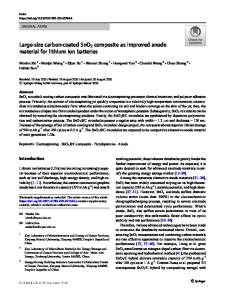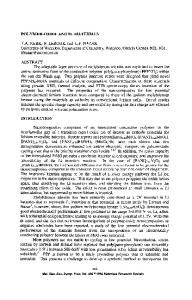Improved Carbon Anode Materials for Lithium-Ion Cells
- PDF / 1,139,011 Bytes
- 6 Pages / 414.72 x 648 pts Page_size
- 41 Downloads / 362 Views
Mat. Res. Soc. Symp. Proc. Vol. 496 © 1998 Materials Research Society
Recently, a foreign manufacturer of mesophase fibers developed an optimized pitch fiber for Lithium-ion applications and reported some very exciting results using this type of mesophase carbon fiber material [4] as an anode. The authors of this study attribute the performance attributes of cells to the radial structure of the mesophase fiber material. [4] This paper presents lithium reference electrical experiments in full lithium-ion cells (3.04.OAh capacity) using mesophase pitch fiber material as the anode and compares them with graphite anodes. These experiments indicate the fiber containing cell significantly resists polarization at the anode during high rates of charge compared to the cells using graphite as an anode. These tests indicate that mesophase fibers are the preferred anode material for high rate applications instead of graphite. In addition, the other dynamics of the cell elucidated from the reference electrode measurements are presented. Results from a cycling experiment on the three commercially available mesophase bead materials are shown and possible explanations of the different behavior presented. Other important parameters effecting cell performance, such as the effect of the carbon materials on cell discharge voltage, coulombic and first cycle efficiencies are also discussed. EXPERIMENT Cell Construction Test cells were made with lithiated nickel oxide cathodes and carbon anodes. The cathodes were made from a slurry of lithiated nickel oxide, graphite, carbon black and PVDF binder dissolved in DMF. After mixing, this slurry was coated onto thin aluminum foil, dried and then compressed. The anodes were prepared in a similar manner where the carbon material (graphite, fiber, bead or petroleum coke) was added to PVDF/DMF solution and coated onto thin copper foil. The anodes were then bagged with Celgard separator material. The prismatic cells have the following parallel configuration anode/separator/cathode ....etc. The lithium reference electrode was prepared by rolling lithium onto a narrow strip of copper foil (93% compared to 75% for the KS-15 material. Some findings for the first cycle irreversible capacity loss associated with mesophase pitch fibers have been reported in the literature. [9] In this study, the amount of lithium was studied on different sections of mesophase pitch carbon ribbons after intercalation/deintercalation cycle. In this system, the amount of lithium was found to be higher at the surface of the deintercalated carbon but significant amounts were also found in the carbon bulk. This has been attributed to active sites such as OH and carbon moieties. On charge, when lithium is intercalated into the carbon electrode, lithium can react with these active sites to form stable compounds which cannot be discharged. The amount of irreversible capacity is dependent on the number of active sites. It was shown that by increasing the heat treatment temperature for mesophase pitch systems, the number of active
Data Loading...










